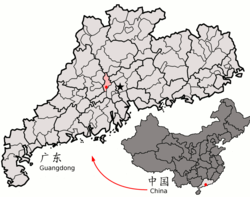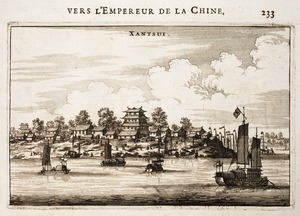Sanshui, Foshan
Sanshui
Tam thủy khu | |
|---|---|
 Sanshui North railway station | |
 | |
 Location of Sanshui District (red) in Foshan City and Guangdong | |
| Coordinates:23°09′21″N112°53′48″E/ 23.15583°N 112.89667°E | |
| Country | People's Republic of China |
| Province | Guangdong |
| Prefecture-level city | Foshan |
| Area | |
| • Total | 874 km2(337 sq mi) |
| Elevation | 11 m (37 ft) |
| Population (2010) | |
| • Total | 622,645 |
| • Density | 710/km2(1,800/sq mi) |
| Time zone | UTC+8(China Standard) |
| Postal code | 528100 |
| Area code | 0757 |
| Licence plate prefix | Việt ET |
| Website | http:// sanshui.gov.cn/ |
| Sanshui, Foshan | |||||||||||||
|---|---|---|---|---|---|---|---|---|---|---|---|---|---|
| Chinese | Tam thủy | ||||||||||||
| Jyutping | Saam1-seoi2 | ||||||||||||
| CantoneseYale | Sāamséui | ||||||||||||
| Hanyu Pinyin | Sānshǔi | ||||||||||||
| Postal | Samshui | ||||||||||||
| Literal meaning | Three Waters Tri-River | ||||||||||||
| |||||||||||||
Sanshui District,formerlyromanizedasSamshui,[a]is anurban districtof theprefecture-level cityofFoshaninGuangdongprovince, China. It had a population of 622,645 as of the 2010 census.[2]It is known for the "Samsui women",emigrants who labour inSingapore,and for a large fireworks explosion in 2008.
History
[edit]According to archaeology sites discovered within the region, there were human beings inhabited in the town of Baini (Bạch nê trấn) Sanshui District about four thousand years ago. Sanshui County was established in the fifth year ofJiajing(1526) in the Ming Dynasty. It was merged intoNanhai Countyin 1959, revoked and restored in 1960, and reorganized into acounty-level cityin 1993. In 2002, it was reorganized into a district and belonged to Foshan City.[3]
In February 2008, twenty fireworks warehouses exploded in Sanshui. In total over 15,000 cartons of fireworks were set off over a period of 24 hours. The loss of inventory was extensive enough that U.S. markets faced real shortages of supply.
Administration divisions
[edit]The neighbouring cities, counties and districts areGaoyao,Dinghu DistrictandSihuiin the west,Qingxin CountyandQingyuanin the north,Huadu DistrictandNanhai Districtin the east andGaoming Districtin the south-west. Sanshui administers 2 subdistricts and 5 towns:[4]
| Name | Chinese(S) | Hanyu Pinyin | Population (2010)[5] | Area (km2) |
|---|---|---|---|---|
| Xinan Subdistrict | Tây Nam đường phố | Xīnán Jiēdào | 283,819 | 178.00 |
| Yundonghai Subdistrict | Vân Đông Hải đường phố | Yúndōnghǎi Jiēdào | 29,953 | 56.00 |
| Lubaotown | Lô bao trấn | Lúbāo Zhèn | 40,626 | 105.00 |
| Datangtown | Đại đường trấn | Dàtáng Zhèn | 46,704 | 98.23 |
| Lepingtown | Nhạc bình trấn | Lèpíng Zhèn | 134,508 | 198.50 |
| Bainitown | Bạch nê trấn | Báiní Zhèn | 64,425 | 66.46 |
| Nanshantown | Nam Sơn trấn | Nánshān Zhèn | 22,610 | 115.62 |

Economy
[edit]Oil, coal, and slate are found in the surrounding area. However, Sanshui is also an important producer of food for Guangdong Province, especially fruit. The mainstay of the former city's economy was theJianlibao Company,which produced a soft drink made from oranges and honey. During the 1990s, Jianlibao was a popular drink throughout China and it even made it into theHong Kongmarket. However, embezzlement by the company's senior management has reduced its success. Despite Sanshui's proximity toGuangzhouand otherPearl River Deltacities, it remains a relatively poor place with many people only earning a few hundred yuan a month.
Transportation
[edit]Sanshui is on the railway line fromGuangzhoutoMaoming.The district is served byG15 Shenyang–Haikou Expressway(which provides access toKaipingand the southern suburbs of Foshan),G55 Erenhot–Guangzhou Expressway(which provides direct access to downtown Guangzhou),China National Highway 321(which provides access toZhaoqing) andChina National Highway 324.
Climate
[edit]| Climate data for Sanshui (2005–2020 normals, extremes 1981–2010) | |||||||||||||
|---|---|---|---|---|---|---|---|---|---|---|---|---|---|
| Month | Jan | Feb | Mar | Apr | May | Jun | Jul | Aug | Sep | Oct | Nov | Dec | Year |
| Record high °C (°F) | 27.2 (81.0) |
29.0 (84.2) |
32.2 (90.0) |
34.1 (93.4) |
35.5 (95.9) |
37.4 (99.3) |
39.1 (102.4) |
38.7 (101.7) |
37.7 (99.9) |
35.0 (95.0) |
32.7 (90.9) |
28.8 (83.8) |
39.1 (102.4) |
| Mean daily maximum °C (°F) | 17.3 (63.1) |
19.5 (67.1) |
21.7 (71.1) |
26.0 (78.8) |
30.2 (86.4) |
32.4 (90.3) |
33.7 (92.7) |
33.5 (92.3) |
32.1 (89.8) |
28.9 (84.0) |
24.4 (75.9) |
19.2 (66.6) |
26.6 (79.8) |
| Daily mean °C (°F) | 13.3 (55.9) |
15.5 (59.9) |
18.2 (64.8) |
22.4 (72.3) |
26.2 (79.2) |
28.3 (82.9) |
29.4 (84.9) |
29.1 (84.4) |
27.9 (82.2) |
24.8 (76.6) |
20.1 (68.2) |
14.9 (58.8) |
22.5 (72.5) |
| Mean daily minimum °C (°F) | 10.5 (50.9) |
12.7 (54.9) |
15.6 (60.1) |
19.6 (67.3) |
23.4 (74.1) |
25.6 (78.1) |
26.3 (79.3) |
26.0 (78.8) |
24.9 (76.8) |
21.6 (70.9) |
17.1 (62.8) |
11.9 (53.4) |
19.6 (67.3) |
| Record low °C (°F) | 1.3 (34.3) |
2.2 (36.0) |
3.1 (37.6) |
8.7 (47.7) |
14.4 (57.9) |
18.5 (65.3) |
21.6 (70.9) |
22.8 (73.0) |
15.8 (60.4) |
10.6 (51.1) |
4.1 (39.4) |
0.3 (32.5) |
0.3 (32.5) |
| Averageprecipitationmm (inches) | 53.1 (2.09) |
53.1 (2.09) |
103.2 (4.06) |
183.5 (7.22) |
258.6 (10.18) |
291.6 (11.48) |
218.9 (8.62) |
246.9 (9.72) |
174.3 (6.86) |
71.9 (2.83) |
43.5 (1.71) |
38.7 (1.52) |
1,737.3 (68.38) |
| Average precipitation days(≥ 0.1 mm) | 7.6 | 10.2 | 15.7 | 15.7 | 18.1 | 18.9 | 17.0 | 15.8 | 11.8 | 5.4 | 5.6 | 5.4 | 147.2 |
| Average snowy days | 0.1 | 0 | 0 | 0 | 0 | 0 | 0 | 0 | 0 | 0 | 0 | 0 | 0.1 |
| Averagerelative humidity(%) | 72 | 77 | 81 | 81 | 81 | 81 | 78 | 78 | 75 | 69 | 68 | 67 | 76 |
| Mean monthlysunshine hours | 98.1 | 71.7 | 55.1 | 69.6 | 109.4 | 131.8 | 182.4 | 176.4 | 169.8 | 177.7 | 148.8 | 134.4 | 1,525.2 |
| Percentpossible sunshine | 29 | 22 | 15 | 18 | 27 | 33 | 44 | 44 | 47 | 50 | 45 | 41 | 35 |
| Source:China Meteorological Administration[6][7] | |||||||||||||
Notes
[edit]References
[edit]- ^Baynes, T. S., ed. (1878),,Encyclopædia Britannica,vol. 5 (9th ed.), New York: Charles Scribner's Sons
- ^Tabulation on the 2010 population census of the people's republic of China by township(1st ed.). Beijing: China Statistics Print. 2012.ISBN978-7-5037-6660-2.
- ^"Thành phố Phật Sơn tam thủy khu cơ bản tình huống tóm tắt".ss.gov.cn.Retrieved2023-04-11.
- ^2011 năm thống kê dùng phân ranh giới số hiệu cùng thành hương phân chia số hiệu: Tam thủy khu(in Simplified Chinese). National Bureau of Statistics of the People's Republic of China.Retrieved2012-07-23.
- ^shi, Guo wu yuan ren kou pu cha ban gong; council, Guo jia tong ji ju ren kou he jiu ye tong ji si bian = Tabulation on the 2010 population census of the people's republic of China by township / compiled by Population census office under the state; population, Department of; statistics, employment statistics national bureau of (2012).Zhongguo 2010 nian ren kou pu cha fen xiang, zhen, jie dao zi liao(Di 1 ban. ed.). Beijing Shi: Zhongguo tong ji chu ban she.ISBN978-7-5037-6660-2.
{{cite book}}:CS1 maint: numeric names: authors list (link) - ^Trung Quốc khí tượng số liệu võng – WeatherBk Data(in Simplified Chinese).China Meteorological Administration.Retrieved28 May2023.
- ^ Trung Quốc khí tượng số liệu võng(in Simplified Chinese).China Meteorological Administration.Retrieved28 May2023.
External links
[edit]- Official website

- .Encyclopædia Britannica(11th ed.). 1911.
